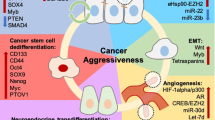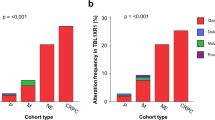Abstract
Prostate cancer is the second leading cause of cancer related deaths in US men, largely because of metastasis, which is ultimately fatal. A better understanding of metastasis biology will lead to improved prognostication and therapeutics. We previously reported 11q13.1 gain was independently predictive of recurrence after radical prostatectomy. Multiple endocrine neoplasia I (MEN1) maps to this region of copy number gain in aggressive prostate tumors and was shown to be the only gene at this locus at increased expression in prostate cancer. Here, we demonstrate an oncogenic role for MEN1 in prostate cancer using a variety of independent assays.
This is a preview of subscription content, access via your institution
Access options
Subscribe to this journal
Receive 4 print issues and online access
$259.00 per year
only $64.75 per issue
Buy this article
- Purchase on Springer Link
- Instant access to full article PDF
Prices may be subject to local taxes which are calculated during checkout





Similar content being viewed by others
References
Chandrasekharappa SC, Teh BT . Functional studies of the MEN1 gene. J Intern Med 2003; 253: 606–615.
Pannett AA, Thakker RV . Multiple endocrine neoplasia type 1. Endocr Relat Cancer 1999; 6: 449–473.
Guru SC, Manickam P, Crabtree JS, Olufemi SE, Agarwal SK, Debelenko LV . Identification and characterization of the multiple endocrine neoplasia type 1 (MEN1) gene. J Intern Med 1998; 243: 433–439.
Lemos MC, Thakker RV . Multiple endocrine neoplasia type 1 (MEN1): analysis of 1336 mutations reported in the first decade following identification of the gene. Hum Mutat 2008; 29: 22–32.
Larsson C, Skogseid B, Oberg K, Nakamura Y, Nordenskjold M . Multiple endocrine neoplasia type 1 gene maps to chromosome 11 and is lost in insulinoma. Nature 1988; 332: 85–87.
Hughes CM, Rozenblatt-Rosen O, Milne TA, Copeland TD, Levine SS, Lee JC et al. Menin associates with a trithorax family histone methyltransferase complex and with the hoxc8 locus. Mol Cell 2004; 13: 587–597.
Yokoyama A, Wang Z, Wysocka J, Sanyal M, Aufiero DJ, Kitabayashi I et al. Leukemia proto-oncoprotein MLL forms a SET1-like histone methyltransferase complex with menin to regulate Hox gene expression. Mol Cell Biol 2004; 24: 5639–5649.
Schussheim DH, Skarulis MC, Agarwal SK, Simonds WF, Burns AL, Spiegel AM et al. Multiple endocrine neoplasia type 1: new clinical and basic findings. Trends Endocrinol Metab 2001; 12: 173–178.
Trump D, Farren B, Wooding C, Pang JT, Besser GM, Buchanan KD et al. Clinical studies of multiple endocrine neoplasia type 1 (MEN1). QJM 1996; 89: 653–669.
Paris PL, Andaya A, Fridlyand J, Jain AN, Weinberg V, Kowbel D et al. Whole genome scanning identifies genotypes associated with recurrence and metastasis in prostate tumors. Hum Mol Genet 2004; 13: 1303–1313.
Lapointe J, Li C, Higgins JP, van de Rijn M, Bair E, Montgomery K et al. Gene expression profiling identifies clinically relevant subtypes of prostate cancer. Proc Natl Acad Sci USA 2004; 101: 811–816.
Perner S, Wagner PL, Demichelis F, Mehra R, Lafargue CJ, Moss BJ et al. EML4–ALK fusion lung cancer: a rare acquired event. Neoplasia 2008; 10: 298–302.
Rubin MA, Putzi M, Mucci N, Smith DC, Wojno K, Korenchuk S et al. Rapid (‘warm’) autopsy study for procurement of metastatic prostate cancer. Clin Cancer Res 2000; 6: 1038–1045.
Bolstad BM, Irizarry RA, Astrand M, Speed TP . A comparison of normalization methods for high density oligonucleotide array data based on variance and bias. Bioinformatics 2003; 19: 185–193.
Thomas PD, Campbell MJ, Kejariwal A, Mi H, Karlak B, Daverman R et al. PANTHER: a library of protein families and subfamilies indexed by function. Genome Res 2003; 13: 2129–2141.
Thomas PD, Kejariwal A, Guo N, Mi H, Campbell MJ, Muruganujan A et al. Applications for protein sequence-function evolution data: mRNA/protein expression analysis and coding SNP scoring tools. Nucleic Acids Res 2006; 34: W645–W650.
Kattan MW, Wheeler TM, Scardino PT . Postoperative nomogram for disease recurrence after radical prostatectomy for prostate cancer. J Clin Oncol 1999; 17: 1499–1507.
Dhanasekaran SM, Barrette TR, Ghosh D, Shah R, Varambally S, Kurachi K et al. Delineation of prognostic biomarkers in prostate cancer. Nature 2001; 412: 822–826.
Dhanasekaran SM, Dash A, Yu J, Maine IP, Laxman B, Tomlins SA et al. Molecular profiling of human prostate tissues: insights into gene expression patterns of prostate development during puberty. FASEB J 2005; 19: 243–245.
Tomlins SA, Mehra R, Rhodes DR, Cao X, Wang L, Dhanasekaran SM et al. Integrative molecular concept modeling of prostate cancer progression. Nat Genet 2007; 39: 41–51.
Vanaja DK, Cheville JC, Iturria SJ, Young CY . Transcriptional silencing of zinc finger protein 185 identified by expression profiling is associated with prostate cancer progression. Cancer Res 2003; 63: 3877–3882.
Varambally S, Yu J, Laxman B, Rhodes DR, Mehra R, Tomlins SA et al. Integrative genomic and proteomic analysis of prostate cancer reveals signatures of metastatic progression. Cancer Cell 2005; 8: 393–406.
Schnepp RW, Mao H, Sykes SM, Zong WX, Silva A, La P et al. Menin induces apoptosis in murine embryonic fibroblasts. J Biol Chem 2004; 279: 10685–10691.
Guru SC, Goldsmith PK, Burns AL, Marx SJ, Spiegel AM, Collins FS et al. Menin, the product of the MEN1 gene, is a nuclear protein. Proc Natl Acad Sci USA 1998; 95: 1630–1634.
La P, Desmond A, Hou Z, Silva AC, Schnepp RW, Hua X . Tumor suppressor menin: the essential role of nuclear localization signal domains in coordinating gene expression. Oncogene 2006; 25: 3537–3546.
Jensen RT . Management of the Zollinger–Ellison syndrome in patients with multiple endocrine neoplasia type 1. J Intern Med 1998; 243: 477–488.
Norton JA, Fraker DL, Alexander HR, Venzon DJ, Doppman JL, Serrano J et al. Surgery to cure the Zollinger–Ellison syndrome. N Engl J Med 1999; 341: 635–644.
Weber HC, Venzon DJ, Lin JT, Fishbein VA, Orbuch M, Strader DB et al. Determinants of metastatic rate and survival in patients with Zollinger–Ellison syndrome: a prospective long-term study. Gastroenterology 1995; 108: 1637–1649.
Milne TA, Hughes CM, Lloyd R, Yang Z, Rozenblatt-Rosen O, Dou Y et al. Menin and MLL cooperatively regulate expression of cyclin-dependent kinase inhibitors. Proc Natl Acad Sci USA 2005; 102: 749–754.
Agarwal SK, Guru SC, Heppner C, Erdos MR, Collins RM, Park SY et al. Menin interacts with the AP1 transcription factor JunD and represses JunD-activated transcription. Cell 1999; 96: 143–152.
Yokoyama A, Somervaille TC, Smith KS, Rozenblatt-Rosen O, Meyerson M, Cleary ML . The menin tumor suppressor protein is an essential oncogenic cofactor for MLL-associated leukemogenesis. Cell 2005; 123: 207–218.
Karnik SK, Chen H, McLean GW, Heit JJ, Gu X, Zhang AY et al. Menin controls growth of pancreatic beta-cells in pregnant mice and promotes gestational diabetes mellitus. Science 2007; 318: 806–809.
Luo J, Duggan DJ, Chen Y, Sauvageot J, Ewing CM, Bittner ML et al. Human prostate cancer and benign prostatic hyperplasia: molecular dissection by gene expression profiling. Cancer Res 2001; 61: 4683–4688.
Snijders AM, Nowak N, Segraves R, Blackwood S, Brown N, Conroy J et al. Assembly of microarrays for genome-wide measurement of DNA copy number. Nat Genet 2001; 29: 263–264.
Acknowledgements
We thank Dr Nora Navone for generously donating the MDAPCA cells, Dr Francis Collins and Dr Lee Burns for kindly providing the MEN1 antibody, Bill Hyun and the UCSF Laboratory for cell analysis for assistance with FACS analysis, Applied Biosystems for supplying the reagents for the expression experiments, Christopher LaFargue for excellent technical assistance with the IHC experiments, and Dr Pankaj Kapahi, Jihad Skaf and Gregory Kronmal for reviewing the article. This work was supported by an RO1 from the National Institutes of Health (CA115484).
Author information
Authors and Affiliations
Corresponding author
Additional information
Supplementary Information accompanies the paper on the Prostate Cancer and Prostatic Diseases website (http://www.nature.com/pcan)
Rights and permissions
About this article
Cite this article
Paris, P., Sridharan, S., Hittelman, A. et al. An oncogenic role for the multiple endocrine neoplasia type 1 gene in prostate cancer. Prostate Cancer Prostatic Dis 12, 184–191 (2009). https://doi.org/10.1038/pcan.2008.45
Received:
Accepted:
Published:
Issue Date:
DOI: https://doi.org/10.1038/pcan.2008.45
Keywords
This article is cited by
-
Men1 disruption in Nkx3.1-deficient mice results in ARlow/CD44+ microinvasive carcinoma development with the dysregulated AR pathway
Oncogene (2021)
-
Exploring the role of miRNAs in renal cell carcinoma progression and metastasis through bioinformatic and experimental analyses
Tumor Biology (2012)
-
Characterisation of prostate cancer lesions in heterozygous Men1 mutant mice
BMC Cancer (2010)



